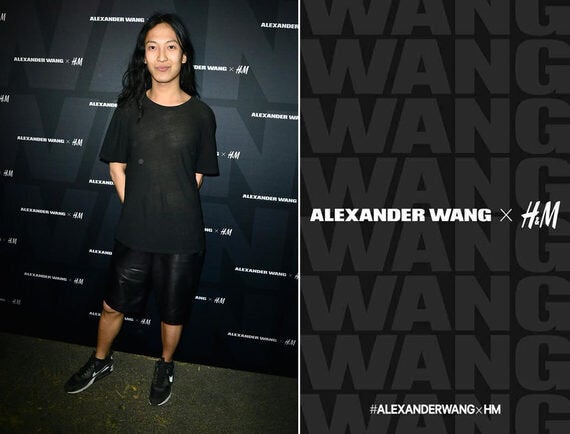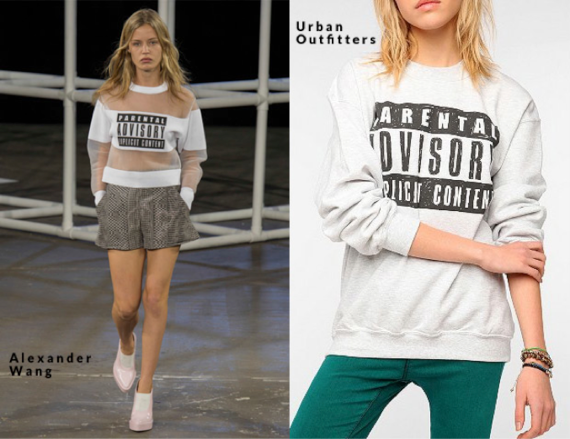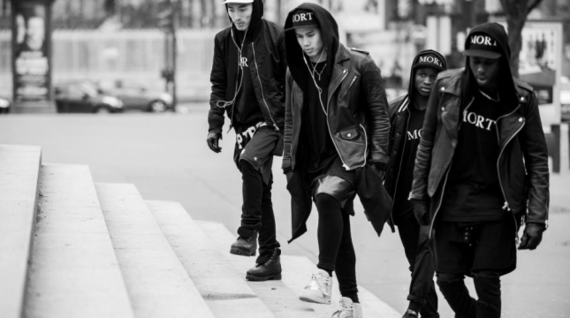
Yes it's true, Alexander Wang and H&M are collaborating.
It was the French Sociologists Bourdieu that first highlighted through surveys conducted in the 1960's that 'fashion has to be brought on to the streets,' and 'haute couture should be within reach of everyone.' The H&M & Alexander Wang collaboration seems to represent exactly that. The American fashion designer Wang is creative director at the French design house Balenciaga considered masterworks of haute couture in the 1950s and 1960s. This particular collection will be rolled out across 250 H&M stores starting November 6th 2014 and is the tenth of H&M's designer collaborations since Karl Lagerfeld's capsule collection in 2004. Other collaborations include Rei Kawakubo and Comme des Garçons (2007) Roberto Cavalli (2007) Valentino (2010) Maison Martin Margiela (2012), Isabel Marant (2013) and also coming this November Osman Yousefzada.
The collaborations between the street and the high-end represent a change in the business of fashion. Amelia Groom in her essay on Japan's contemporary street fashion culture observes that 'change in fashion has often been explained as a 'trickle-down' effect of class imitation followed by class aversion.' But as she aptly identifies 'mutations in fashion can no longer be understood as a simple process of diffusion from the elites to the masses.' The system of fashion is much more complex. In particular, Alexander Wang's collaboration with H&M gives us an opportunity to examine the relationship between the 'high street' and 'high fashion' and also simultaneously consider intellectual property issues that have been converted into mid-level market strategies to ameliorate the rise of the 'copy.'
But before we do so, let's take a moment to consider cultural theory. I spend a lot of time considering what 'cultural theory' can offer law in general, and intellectual property in particular. Bourdieu in his seminal work 'distinction' makes the case that the legitimate taste of the society is the taste of the ruling class - that all 'legitimate taste' is merely 'class taste.' Cultural studies, as with law and fashion has long been in the business of understanding 'legitimisation' - each of these fields struggle with issues revolving around 'reproduction' and offers an interesting tripartite lens from which to view these issues. From my perspective if we look at fashion collaborations through a cultural and legal lens, such partnerships allow designers to extend beyond their traditional associations and tap into an entirely different market, one to a large extent that is already (through the availability of cheaper variations) consuming its designs, to in other words 'legitimately' introduce their designs to a fashion mass-market. It makes sense to me that designers would be seeking to appeal to a market that is characterised for churning out knock-off designs, and at the same time these collaborations can be viewed as an opportunity to create brand awareness.
Intellectual Property
Since the modern French couturier Paul Poiret attempted to protect his unique couture designs from being knocked-off by American manufactures in 1919, intellectual property has been an on-going issue for the fashion industry. Social media and technology has closed the gap between what is seen on the runways and what the fashion world see's which along with it has also thrown a spotlight on the interpolation of inspiration and imitation that ineptly moves between high-street to runway.
Fashion as an industry works 6 months ahead, so fast-fashion retailers have the ability through mass-production to bring similar and almost identical market variations of designer outfits to the public within weeks -- and at a fraction of the price. Take H&M as an example they were criticised only last year for one of their collections looking 'identical' to the high-end designs of Balenciaga, Celine and Kenzo' here.
The Connection Economy & Disruption
Social media has made us all so much more designer literate, we are able see more clearly than ever before, what goes on in the world of fashion, this includes where designers draw their inspiration from - making it easier for us to draw the connections. These issues though not exclusive to technological advances, are consequential of them, and in this way, designers who are collaborating with 'high street' retailers are 'effectively' 'embracing' as opposed to resisting 'creative disruption.'
There is some research theorised on the relationship between intellectual property and fashion that suggests that copying is beneficial for the industry, that low enforcement of intellectual property actually spurs innovation & creativity across the industry (Blakely). But in conversation with Imran Amed founder of Business of Fashion whilst at the London College of Fashion this past week, I asked him some questions to gauge his thoughts on IP, copying and creativity for the industry, he lamented that even though he can imagine how 'an academic in an ivory tower could come up with such a theory.' That the reality, from his perspective is different, the designers he knows and meet create because "they are driven by creativity" and "walking down Regents St, it turns [his] stomach to see high street retailers steal from young East London designers." So while this theory on 'innovation, creativity & IP' for the fashion industry is interesting, and certainly has inspired my curiosity along with others I am sure in the legal-fash industry, It is perhaps not complete in its representation of IP's relationship and value for the fashion industry and still leaves a question unanswered; does copying cause significant damage to those designer brands in the creative economy?
The rise of high street and high fashion
Culture produced by ordinary people is repacked and sold to them. - Toby Miller
There has always been a dialogic relationship between high fashion and the street. Designers are renowned for tapping into the reservoirs of culture be it past, present & future, to seek inspiration for their designs, and to a large extent, there is nothing wrong with that, we all seek inspiration from outside. However Mark Tungate, author of "Fashion Brands: Branding Style From Armani to Zara" observes, "It can go the other way. The street influences the runway." Designers have been drawing inspiration from the streets for years. He brings to our attention to the reality that "[Couture designers] send photographers onto the streets to see what young kids are wearing and to try to get ideas," Vivienne Westwood, in1980-89 for example transformed "street" provocateur to high-end fashion design through her aestheticisation & interpretation of subcultural style.
We see this also play out through Wang's designs. Take Wang's ss14 pullover bearing the parental advisory logo from hip-hop music culture, retailing on his site for £833, Wang taps into street codes and channels high fashion through the lens of subculture, and look at the very similar Parental Advisory Teeshirt from the high-street retailer Urban Outfitter retailing at (£18) But who copied who first?

Alexander Wang vs. Urban Outfitters
In their book Borrowed Power: Essays on Cultural Appropriation, Bruce Ziff and Pratima V. Rao define cultural appropriation as "the taking from another culture that is not one's own of intellectual property, cultural expressions or artifacts, history and ways of knowledge.' However, in fact, as Fashionista points out, Urban was actually selling the sweatshirt for months prior to Wang's show. It is commonly acknowledged that the high street copies the catwalk. It is rarely acknowledged the ways the fashion elite copy the street. indeed street style and synonymously high street fashion are 'tastemakers' in there own right.

So fashion collaborations represent an interesting 'turn' in fashion, perhaps the logic of which we can see connected to issues of intellectual property. 'Taste' is dictated by a mixture of the 'high' and the 'low' a recipe that reminds us that fashion isn't just about money, but also culture, style and creativity. As fashion blogger Susie Bubble recently said, 'fashion is creativity first and commerce second' but if IP is the cultural currency of creativity and what helps to turn fashion into a commercial industry - it is worth us asking some serious questions about the value intellectual property for those (especially emerging) designers engaged in the production of culture in the connected creative economy?
Tania Phipps-Rufus is studying for her PhD on fashion, intellectual property & visual culture in the creative economy (University of Bristol). She is also a researcher working on project at the University of Goldsmith with Professor Angela McRobbie, on 'Fashion IP: From start-up to catwalk, a four city investigation,' for CREATe the centre for new business models in the creative economy and previously was a lecturer of intellectual property law at Hertfordshire University.
References:
Rocamora, Agnes. "Fields of Fashion Critical insights into Bourdieu's sociology of culture." Journal of Consumer Culture 2.3 (2002): 341-362.
Pierre, Bourdieu. "Haute culture et haute couture." Questions de sociologie, Paris, Édition de Minuit (1984): 196-206.
Groom, Amelia. "Power Play and Performance in Harajuku." New Voices 4.1 (2011): 188-210.
Tungate, Mark. Fashion brands: branding style from Armani to Zara. Kogan Page Publishers, 2008.
Ziff, Bruce H., and Pratima V. Rao, eds. Borrowed power: Essays on cultural appropriation. Rutgers University Press, 1997.
Bourdieu, Pierre. Distinction: A social critique of the judgement of taste. Harvard University Press, 1984.